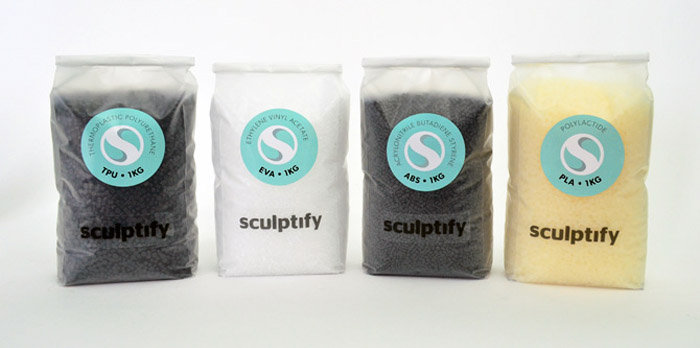There’s an image in the mind of most people introduced to desktop 3D printing of a long tube of plastic filament going into one end of a printer and coming out as a 3D object at the other. Sculptify, which plans to launch on Kickstarter soon, hopes to change that image with its FLEX 3D printing process, and for good reason.
With fused filament fabrication, the process used by most desktop 3D printers, the big spools of plastic filament are derived from plastic pellets. The little beads of plastic are fed into an extruding device, melted, and shaped into long tubes (one example is illustrated above). Sculptify bypasses this process completely with FLEX, short for Fused Layer EXtrusion. The Sculptify 3D printer prints using the pellets themselves. This is not the first time this approach has been posited, the industrial Arburg 3D printer, the Freeformer, introduced last year, also prints directly from plastic pellets.
As you might guess, by skipping an entire engineering step, users could likely save a great deal of money on feedstock. Also, with fewer steps in material processing, there’s less opportunity to cause imperfections in the material. And Sculptify claims that, with bags of pellets, “[their] printer is as easy to load as a coffee maker. Simply grab your bag of material, open the printer lid, and scoop in the material of your choice. After a few short minutes, the system will be heated and ready to print – that’s it.” The company also believes that FLEX allows for the use of a wider variety of 3D printing materials.
Something I hope they’re working on is the ability to use recycled materials in 3D printing. As RichRap pointed out in a previous article on the pursuit of ethical filament manufacturing, that “[f]undamental 3D printing technology could also be altered to make plastic recycling easier to self-implement, many people have commented over the years that melting plastic into filament form, only to re-melt it in a 3D printer is a number of steps more complicated than it really needs to be.” Though a pellet printer may not make printing with recycled materials possible directly, it does have the potential to remove an unnecessary step in fabbing with them. There is still, as Rich also points out, the issue of quality control, as homemade pellets may not be processable by the Sculptify machine and the output may not meet production standards. Still, the FLEX process for desktop printing opens up a range of new possibilities.
Source: Sculptify




